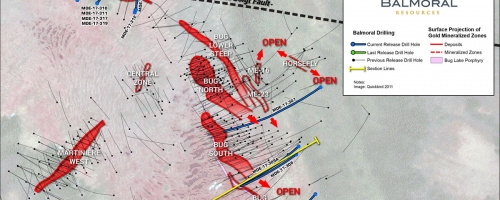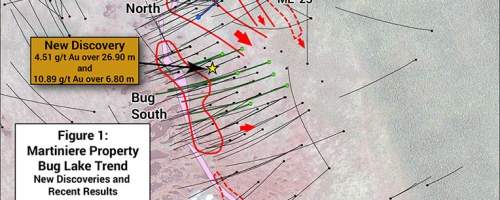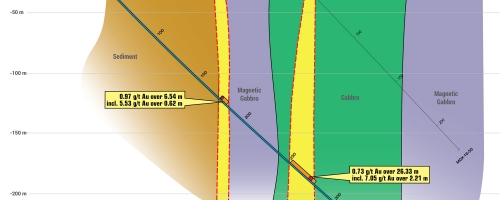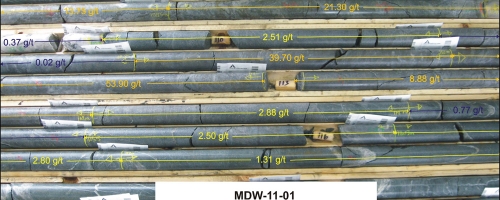Gold Mineralization
MARTINIERE GOLD SYSTEM
The Martiniere Gold System is a large mesothermal gold bearing system similar to those which host over 70 million ounces of historic gold production throughout the Abitibi. Discovered under extensive overburden cover the system has been traced for up to 4.0 kilometres in an east-west direction and for up to 2.0 kilometres in a north-south direction. The system, like most large gold systems in the Abitibi, is bordered on the south by a regional deformation zone – in this case the Sunday Lake deformation zone which hosts the multi-million ounce Detour Gold deposit 40 kilometres to the west.
To date Balmoral has discovered two prominent gold bearing trends within the broader system as well as several occurrences. The two main gold bearing trends (or shear/fault structures) are the north-south striking Bug Lake Gold Trend and the northeast striking Martiniere West Trend.
Martiniere East VMS System
Drilling by Balmoral in 2011 along projected strike of the Martiniere West Zone and Martiniere Central Zone intersected a broad (20-50 metre wide) zone of semi-massive to massive pyrite mineralization and intense chlorite alteration east of the Bug Lake Fault (the Martiniere East area). This pyrite-rich mineralized zone appears to represent a Volcanogenic Massive Sulphide (VMS) feeder zone (or pipe). The pyrite rich sections typically exhibit anomalous (100 to 1000 ppb) gold mineralization but very weak base metal values. Detailed core logging has identified a locally developed exhalative horizon sitting stratigraphically above this feeder zone and narrow brecciated intervals developed proximal to the exhalative horizon have exhibited very high gold and silver grades. Drilling during the winter of 2015 intersected a 2.3 metre thick intercept of semi-massive to massive base metal bearing sulphides within the Bug Lake fault system. While likely displaced from source, this new discovery suggests potential for base metal sulphide development within the Martiniere East system which requires further investigation at depth and along strike.
The Martiniere Gold System is a large mesothermal gold bearing system similar to those which host over 70 million ounces of historic gold production throughout the Abitibi. Discovered under extensive overburden cover the system has been traced for up to 4.0 kilometres in an east-west direction and for up to 2.0 kilometres in a north-south direction. The system, like most large gold systems in the Abitibi, is bordered on the south by a regional deformation zone – in this case the Sunday Lake deformation zone which hosts the multi-million ounce Detour Gold deposit 40 kilometres to the west.
To date Balmoral has discovered two prominent gold bearing trends within the broader system as well as several occurrences. The two main gold bearing trends (or shear/fault structures) are the north-south striking Bug Lake Gold Trend and the northeast striking Martiniere West Trend.
Martiniere East VMS System
Drilling by Balmoral in 2011 along projected strike of the Martiniere West Zone and Martiniere Central Zone intersected a broad (20-50 metre wide) zone of semi-massive to massive pyrite mineralization and intense chlorite alteration east of the Bug Lake Fault (the Martiniere East area). This pyrite-rich mineralized zone appears to represent a Volcanogenic Massive Sulphide (VMS) feeder zone (or pipe). The pyrite rich sections typically exhibit anomalous (100 to 1000 ppb) gold mineralization but very weak base metal values. Detailed core logging has identified a locally developed exhalative horizon sitting stratigraphically above this feeder zone and narrow brecciated intervals developed proximal to the exhalative horizon have exhibited very high gold and silver grades. Drilling during the winter of 2015 intersected a 2.3 metre thick intercept of semi-massive to massive base metal bearing sulphides within the Bug Lake fault system. While likely displaced from source, this new discovery suggests potential for base metal sulphide development within the Martiniere East system which requires further investigation at depth and along strike.




